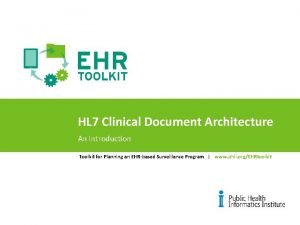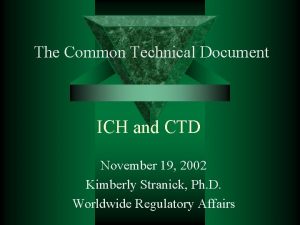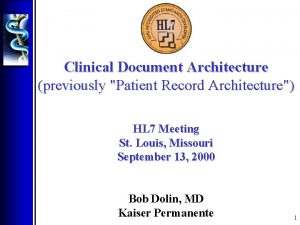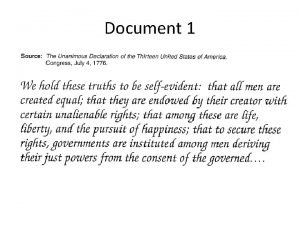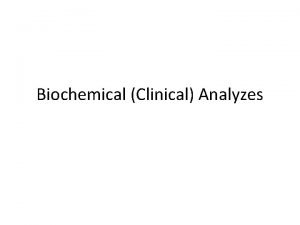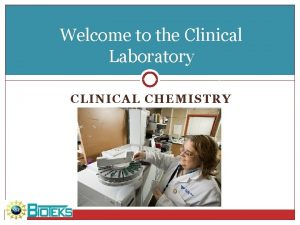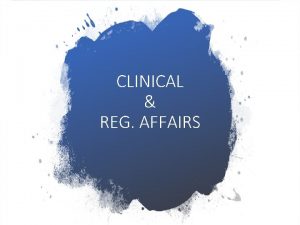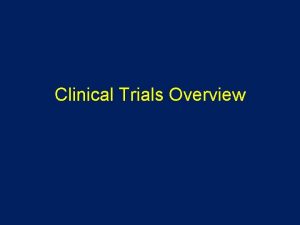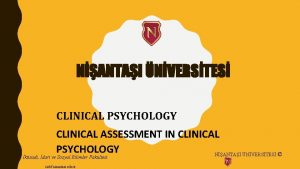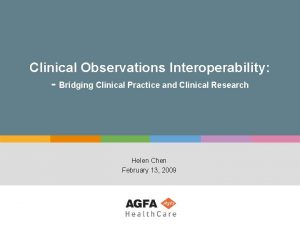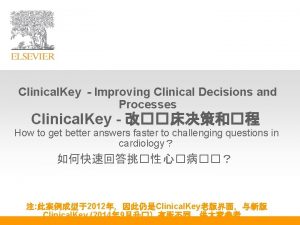Clinical Document Architecture for Common Document Types PEHRC















































- Slides: 47

Clinical Document Architecture for Common Document Types PEHRC June 18, 2007 Liora Alschuler 1

Liora Alschuler – Consultant in healthcare IT 1997 -present • Background in electronic text, industry analyst with Seybold Publications, xml. com • Author, ABCD. . . SGML: A Manager’s Guide to Structured Information, 1995 • Founded consulting firm in 2005 – Volunteer standards work • Health Level Seven Board of Directors (2005 -2008) • Co-chair Structured Documents Technical Committee • Co-editor Clinical Document Architecture (CDA) – liora@alschulerassociates. com 2

Alschuler Associates, LLC • Consultants in standards-based solutions for healthcare information working with vendors, providers, standards developers • Clients – Military Health System • Enterprise-wide documents, files, images (DFIEA) – Centers for Disease Control and Prevention • Implementation Guide for infectious disease reporting (NHSN) – North American Association of Central Cancer Registries • Implementation Guide for cancer abstracts – Department of Health and Human Services • Subcontracts on Health IT Standards Panel (HITSP) and Health Information Standards for Privacy and Confidentiality (HISPC) – American Hospital Association • Use case development for healthcare IT standards initiative – CDA 4 CDT • Co-founder & Project Management – Private, commercial clients: Fortune 100 and startups • www. alschulerassociates. com 3

• HL 7 • CDA – what is it – where is it used • CCD • CDA 4 CDT – & the PEHRC 4

Health Level Seven • Non-profit ANSI Standards Development Organization • 20 years old • 2000+ members – individual, corporate • 30 affiliates – US affiliate in near future • “A model community”: building standards to a single information model 5

HL 7 Steering Divisions Foundation & Technologies • Implementable Technology Specifications Structure & Semantic Design • Implementation/Conformance • Clinical Context Object • Infrastructure & Messaging • Java. Workgroup • Clinical Decision Support • Modeling & Methodology • Electronic Health Record • Security • Financial Management • Service Oriented Architecture • Genomics • Templates • Orders & Observations • Vocabulary • Patient Administration • Scheduling & Logistics • Structured Documents Domain Experts • Anesthesiology • Attachments • Cardiology • Clinical Guidelines • Community Based Collaborative Care • Emergency Care • Government Projects • Health Care Devices • Imaging Integration • Laboratory • Patient Care • Patient Safety • Pediatrics Data Standards • Public Health Emergency Response • Pharmacy • Regulated Clinical Research Information Management 6

CDA: A Document Exchange Specification • • This is a CDA and this and this 7

The CDA document defined CDA Release 2, section 2. 1: A clinical document. . . has the following characteristics: · Persistence · Stewardship · Potential for authentication · Context · Wholeness · Human readability • therefore, CDA documents are not: – data fragments, unless signed – birth-to-death aggregate records – electronic health records 8

CDA Design Principles • priority is patient care, other applications facilitated • minimize technical barriers to implementation • promote longevity of clinical records • scoped by exchange, independent of transfer or storage • enable policy-makers to control information requirements 9

Sample CDA • Header • Body – Readable: required – Computable: optional 10

CDA Header: Metadata • Identify – Patient – Provider – Document type. . . • Sufficient for – – – required Medical records management Document management Registry/repository Record locator service Store, query, retrieve 11

CDA Body: Human-readable report • Any type of clinical document – – H&P Consult Op note Discharge Summary. . . • Format: tif, PDF, HTML, XML: – – – – Paragraph List Table Caption Link Content Presentation required 12

CDA Body: Machine Processible – Model-based computable semantics: • • • Observation Procedure Organizer Supply Encounter Substance Administration Observation Media Region Of Interest Act Optional 13

CDA: Incremental Semantic Interoperability • Standard HL 7 metadata • Simple XML for point of care human readability • RIM semantics for reusable computability (“semantic interoperability”) 14

Primary Use Cases • access/portability/exchange – query/locate by patient, provider, practitioner, setting, encounter, date – access distributed information through common metadata – document management • integration – transcription systems – EHR records • re-use/derivative data – summaries, reports – decision support 15

CDA for Information Exchange in the US • Recommended by Health Information Technology Standards Panel (HITSP) work groups • CMS Notice of Proposed Rule Making – Claims attachments using CDA + X 12 – First pilot concluded, others underway • Widespread vendor adoption: – Integrating the Healthcare Enterprise – CDA 4 CDT – Other 16

Current Implementation: US • Mayo Clinic – Initiated in 1999 – About 50, 000 documents each week – Clinical documents: Most important capital asset • New York Presbyterian – – • “CDA Philosophy”: mix of fielded data and narrative Best format for information mining and aggregation across applications Clinical notes contain critical information in narrative 1/3 of all discharges summaries Military Health System – Documents, Files, Images Enhanced AHLTA (DFIEA) • Enterprise-wide document management • Web-services gateway to VA, civilian providers – MHS/VHA Bi-direction Health Information Exchange – Enterprise Wide Referrals and Authorizations • University of Pittsburgh Medical Center – Narrative notes using speech recognition, NLP – Linking radiology reports with PACS-rendered image • Other – Kaiser, Trinity, Partners, Ochsner. . . 17

CDA for Information Exchange • IHE choice for Medical Summaries: 2006 Medi. Notes Next. Gen Healthcare Information Systems All. Scripts GE Healthcare Philips Medical Systems Mc. Kesson Cap. Med/IBM Eclipsys Medical Informatics Engineering Dictaphone Epic Systems GE Healthcare Misys Healthcare Systems Siemens Medi. Notes e Next. Gen EMR Touchworks EHR Centricity® Enterprise Solution (formerly Carecast) Xtenity Horizon Ambulatory Care Personal Health. Key Sunrise Webchart Enterprise Workstation Epic. Care Centricity® Physician Office Misys Connect Soarian 18

Allscripts Touchworks GE Centricity Siemens Soarian (XML) IHE Medical Summaries HIMSS 2006: a CDA Gallery Medi. Notes e Siemens Soarian (PDF) Eclipsys Sunrise 19

CDA for Information Exchange • IHE choice for profiles: 2007 ========== XPHR XDMS - Referral EDR =========== Capmed XDS-SD Allscripts GHNIHE ====== Bell/XWave Epic Nextgen Blueware Epic ====== Medinotes Capmed GE XDMS - Discharge Misys ====== CGI Medinotes ====== XD-LAB CPSI MIE ============ GE Misys BPPC Bell/XWave GE Healthcare IBM Nextgen ==== Eclipsys Infinitt Allscripts Epic MIE Capmed GE Misys Medinotes No. More. Clipboard Quovadx Medquist Quovadx MIE SMS Misys Softmedical Nextgen http: //ihewiki. wustl. edu/wiki/index. php/Chicago 20 Tiani Spirit 2007 -Connectathon-Registered-Documents

CDA & CCD • IHE Profiles 2005 -2007 based on the Care Record Summary (CRS) – first standard implementation guide for CDA – restricted to “level 2” to avoid competition w/CCR – covered a wider number of use cases • IHE 2007 -2008 will move to conform with CCD • New CDA implementation guides also conform with CCD 21

ASTM CCR+HL 7 CDA = CCD • The primary use case for the ASTM CCR is to provide a snapshot in time containing a summary of the pertinent clinical, demographic, and administrative data for a specific patient. • From its inception, CDA has supported the ability to represent professional society recommendations, national clinical practice guidelines, standardized data sets, etc. • From the perspective of CDA, the ASTM CCR is a standardized data set that can be used to constrain CDA specifically for summary documents. • The resulting specification is known as the Continuity of Care Document (CCD). 22

Continuity of Care Document • CCD maps the CCR elements into a CDA representation. CCR data element CDA R 2 correspondence Results Section Result Observation Date. Time Observation / effective. Time IDs Observation / id Description Observation / code Status Observation / status. Code 23

Continuity of Care Document • CCD maps the CCR elements into a CDA representation. <Results> <section> <Result> <code="30954 -2“ <CCRData. Object. ID> code. System="2. 16. 840. 1. 113883. 6. 1" 2. 16. 840. 1. 113883. 19. 1 code. System. Name="LOINC"/> </CCRData. Object. ID> <title>Laboratory results</title> <Date. Time> <text> <Type> CBC (04/07/2000): HGB 13. 2; WBC 6. 7; PLT 123* <Text>Assessment Time</Text> </text> </Type> <entry> <Exact. Date. Time> <observation class. Code="OBS" mood. Code="EVN"> 200004071430 <id root="2. 16. 840. 1. 113883. 19" extension=" </Exact. Date. Time> <code="43789009" </Date. Time> code. System="2. 16. 840. 1. 113883. 6. 96" <Type> code. System. Name="SNOMED CT" <Text>Hematology</Text> display. Name="CBC WO DIFFERENTIAL"/> </Type> <status. Code code="completed"/> <Description> <effective. Time value="200004071430"/> <Text>CBC WO DIFFERENTIAL</Text> <Code> <Value>43789009</Value> <Coding. System>SNOMED CT</Coding. System> </Code> </Description> <Status><Text>Final Results</Text></Status> 24

CDA Business Case • Gentle on-ramp to information exchange - CDA is straight-forward to implement, and provides a mechanism for incremental semantic interoperability. • Improved patient care - CDA provides a mechanism for inserting best practices and evidence-based medicine directly into the process of care (via the same “template” mechanism used to build CCD), thereby making it easier to do the right thing. • Lower costs – CDA provides necessary information to coordinate care, reducing redundant testing and optimizing care delivery for quality and cost. • CDA hits the “sweet spot” – CDA encompasses all of clinical documents. A single standard for the entire EHR is too broad. Multiple standards and/or messages for each EHR function may be difficult to implement. CDA is “just right”. 25

CDA beyond CCD • Not everything we want to exchange is a summary • Let’s look at what’s happening with development of other document types. . . 26

Other CDA content profile development – Within HL 7: • Clinical domains: anatomic pathology, imaging, lab, anesthesiology, pediatrics, long term care, others? • ASIG: HIPAA Attachments – adding dental – Outside HL 7: Public health & MDS • NAACCR Cancer abstracts (no HL 7 ballot) • CDC Infectious Disease Reports (will be HL 7 ballot) • MDS: soon, from HHS – IHE • 2006: 1 content type built on HL 7 CRS • 2007: 7 content types, some constrain CRS, others new • Current cycle: – updating all to be consistent with CCD – adding Discharge Summary – CDA 4 CDT 27

CDA for Common Document Types • Project initiated in January, 2007 – M*Modal – AHDI(was AAMT)/MTIA – AHIMA • Strong support from dictation / transcription and document management industries • Cooperation/coordination with HL 7, IHE, EHR vendors and providers 28

CDA 4 CDT Mission • Develop CDA Implementation Guides (IGs) for common types of electronic healthcare documents • Bring them through the HL 7 ballot process • Promote their use and adoption by healthcare organizations and health information exchange networks 29

Rationale • Enlarge and enrich the flow of data into the electronic health record • Speed the development of interoperable clinical document repositories • Bridge the gap between narrative documents produced through dictation and the structured, computable records within an EHR 30

Why would physicians promoting the EHR have an interest in documents? • Assumptions: – EMR/EHR is the solution – Documents are the problem • Questions: – Are they mutually exclusive or complementary? – Can e. Documents bridge the gap? 31

Problems with Documents • Can’t compute • Can’t automate decision support • Can’t validate conformance to content requirements • And why are they still prevalent? – – Nuanced & precise Support human decision making Retain current workflow e. Documents support narrative & codes • multiple indices optimized for reimbursement, decision support, quality metrics, research • Document management completes the EMR 32

Why encourage continued use of documents? • Worst case: – no computable clinical data – no reuse – + information at the point of care • Best case: – fully computable data to populate EHR • Likely case: – section-level reuse (i. e. HPI pre-populates Discharge Summary) – we can do this now – gradual rise in semantic interoperability 33

Why not keep pushing for fully interoperable records? • Semantic interoperability is hard – over 250, 000 concepts in SNOMED CT – we can’t give up, we need safe computability • Need information at the point of care • Networks need data: self-sustaining networks have Big Data – Initial ROI will spur further investment – MTIA members process 300 M documents/year • Complex systems are built from simple systems • CDA: no loss of computability minimum metadata today future 34

CDA 4 CDT: bridging the gap between EHRs and e. Documents • CDA 4 CDT will: – Establish consensus on content using CDA e. Document format – Propagate support for CDA within the dictation/transcription industry – Create consistent electronic documents for importation into EMR, document repositories and health information exchanges – Increase EMR adoption • Highest potential: – Massively increase amount of data in fledgling exchange networks because minimally disruptive to current workflow • Defining success: – At least 25% of RFPs for transcription, EMRs, integration and information exchange cite compliance as a requirement 35

CDA 4 CDT • Scope – Develop implementation guide for use across the industry – Rapid development, leverage framework, precedents – Establish section-level content, reuse section templates • H&P Timeline – Initial draft in 7 weeks – Balloted as HL 7 Draft Standard for Trial Use • March 26 ballot open, April 24 close • Ballot reconciliation approximately 5 weeks • Revised draft to ballot in August • Consult Note Timeline – Target August 2007 initial ballot • Discharge Summary: Coordinating with IHE on publication – Target publication fall 2007 36

Technical working group • A focused group of working volunteers – prior knowledge of CDA – experience implementing CDA – familiarity with the current set of CDA implementation guides • Participation is open at all stages of the ballot and ballot review process • CDA 4 CDT retains no copyright of balloted material 37

H&P Method • Review precedents: – ASTM’s Standard Specifications for Healthcare Document Formats (E 2184. 02) (Headings and subheadings used in the healthcare industry and associated with specific report types) – HL 7/ASTM Continuity of Care Document (CCD) – Clinical LOINC document and section codes – HL 7 ASIG CDA R 2 Attachment for Clinical Notes – HL 7 Care Record Summary (CRS) – IHE profiles, including the content profiles within Patient Care Coordination – MHS/Do. D-VA-IM-IT Demo Project Discharge Summary and SOAP HL 7 CDA R 2 Implementation Guides • Review samples/templates: – Sample CDA documents developed for local provider institutions (Mayo Clinic, University of Pittsburgh Medical Center, New York Presbyterian, and others) – Non-CDA sample documents supplied by participating providers and vendors – H&P templates from AHIMA, vendors, providers • Statistical analysis: over 15, 000 dictated H&Ps by M*Modal • Test design against samples 38

Draft H&P 39

Ballot results • 78 comments received – ACP, Trinity Health, Kaiser Permanente, VHA, Regenstreif – Epic, GE, Medquist, Northrop • All comments addressed – All negatives will be withdrawn – Draft in revision – Will re-ballot in August/September • If passed, will be “Draft Standard for Trial Use” (DSTU) – stable platform for implementation – within 2 years either normative or revised 40

Ballot issues • Most difficult – balance diversity of current practice against desire for consistency – where can you lead the industry, where must you follow? • Clarify intended content – Past Medical History vs. Surgical History • Physical exam: diversity of practice – Define full set of sub-headings – Allow narrative &/or sub-sections 41

Consult Note • Same method as H&P – – consistent with precedents large scale analysis of dictated notes reuse section-level content review E&M guidelines • Examine required metadata • Examine report contents – Require “reason for referral” – Relationship with “reason for visit”, “chief complaint” • Seeking pre-ballot review 42

Future work • Horizontal: additional document types – Op note – Specialize the History & Physical • Vertical: supporting implementation – Quick Start Guides for implementers – Training for implementers • Promotion: Among providers – Education on utility, strategic value – End-user training for compliance • Whatever it takes to support and promote widespread adoption 43

How can PEHRC, PEHRC members get involved? • Participate in design review – through CDA 4 CDT – through HL 7 Structured Documents TC – through HL 7 Board of Directors • Participate in the ballot – as HL 7 member or non-member • Encourage implementation – within professional society – within practice group 44

CDA for Common Document Types • Founders: • Benefactors: • Participants: Acusis, Kaiser Permanente, Mayo Clinic, Military Health System, University of Pittsburgh Medical Center, GE Healthcare • Management: 45

HL 7: patient-centered health information HL 7 TC/SIG RCRIM SDTC Pharmacy Lab Image Int. Patient Care Decision Support Public Health Pharmacy Discharge medications PCP followup Consult New drug information PHR/EHR Vocabulary Services Knowledge Base R&D Study Develop Report HL 7 Standards RIM-Data. Types-ITS SPL CDA: Discharge Sum V 3 msg: Med Order CDA: lab, imaging V 2: lab Arden ICSR a. ECG CT Lab Stability MOUs X 12, ADA ASTM, CEN CDISC, DICOM, e. HI IEEE, IHE, OASIS, OMG, NCPDP, CAP, WEDI 49

CDA from Dictation • narrative documents can be enhanced through natural language processing and use of templates with no disruption to the existing M*Modal view of “validation display” workflow 50
 Clinical document architecture
Clinical document architecture Document
Document Ctd sections
Ctd sections Kontinuitetshantering i praktiken
Kontinuitetshantering i praktiken Typiska novell drag
Typiska novell drag Tack för att ni lyssnade bild
Tack för att ni lyssnade bild Ekologiskt fotavtryck
Ekologiskt fotavtryck Varför kallas perioden 1918-1939 för mellankrigstiden?
Varför kallas perioden 1918-1939 för mellankrigstiden? En lathund för arbete med kontinuitetshantering
En lathund för arbete med kontinuitetshantering Underlag för särskild löneskatt på pensionskostnader
Underlag för särskild löneskatt på pensionskostnader Personlig tidbok för yrkesförare
Personlig tidbok för yrkesförare A gastrica
A gastrica Densitet vatten
Densitet vatten Datorkunskap för nybörjare
Datorkunskap för nybörjare Stig kerman
Stig kerman Debattartikel struktur
Debattartikel struktur Delegerande ledarstil
Delegerande ledarstil Nyckelkompetenser för livslångt lärande
Nyckelkompetenser för livslångt lärande Påbyggnader för flakfordon
Påbyggnader för flakfordon Kraft per area
Kraft per area Publik sektor
Publik sektor I gullregnens månad
I gullregnens månad Presentera för publik crossboss
Presentera för publik crossboss Teckenspråk minoritetsspråk argument
Teckenspråk minoritetsspråk argument Plats för toran ark
Plats för toran ark Klassificeringsstruktur för kommunala verksamheter
Klassificeringsstruktur för kommunala verksamheter Mjälthilus
Mjälthilus Bästa kameran för astrofoto
Bästa kameran för astrofoto Centrum för kunskap och säkerhet
Centrum för kunskap och säkerhet Lågenergihus nyproduktion
Lågenergihus nyproduktion Mat för idrottare
Mat för idrottare Verktyg för automatisering av utbetalningar
Verktyg för automatisering av utbetalningar Rutin för avvikelsehantering
Rutin för avvikelsehantering Smärtskolan kunskap för livet
Smärtskolan kunskap för livet Ministerstyre för och nackdelar
Ministerstyre för och nackdelar Tack för att ni har lyssnat
Tack för att ni har lyssnat Referat mall
Referat mall Redogör för vad psykologi är
Redogör för vad psykologi är Borstål, egenskaper
Borstål, egenskaper Tack för att ni har lyssnat
Tack för att ni har lyssnat Borra hål för knoppar
Borra hål för knoppar Vilken grundregel finns det för tronföljden i sverige?
Vilken grundregel finns det för tronföljden i sverige? R formel
R formel Tack för att ni har lyssnat
Tack för att ni har lyssnat Rita perspektiv
Rita perspektiv Informationskartläggning
Informationskartläggning Tobinskatten för och nackdelar
Tobinskatten för och nackdelar Toppslätskivling effekt
Toppslätskivling effekt
